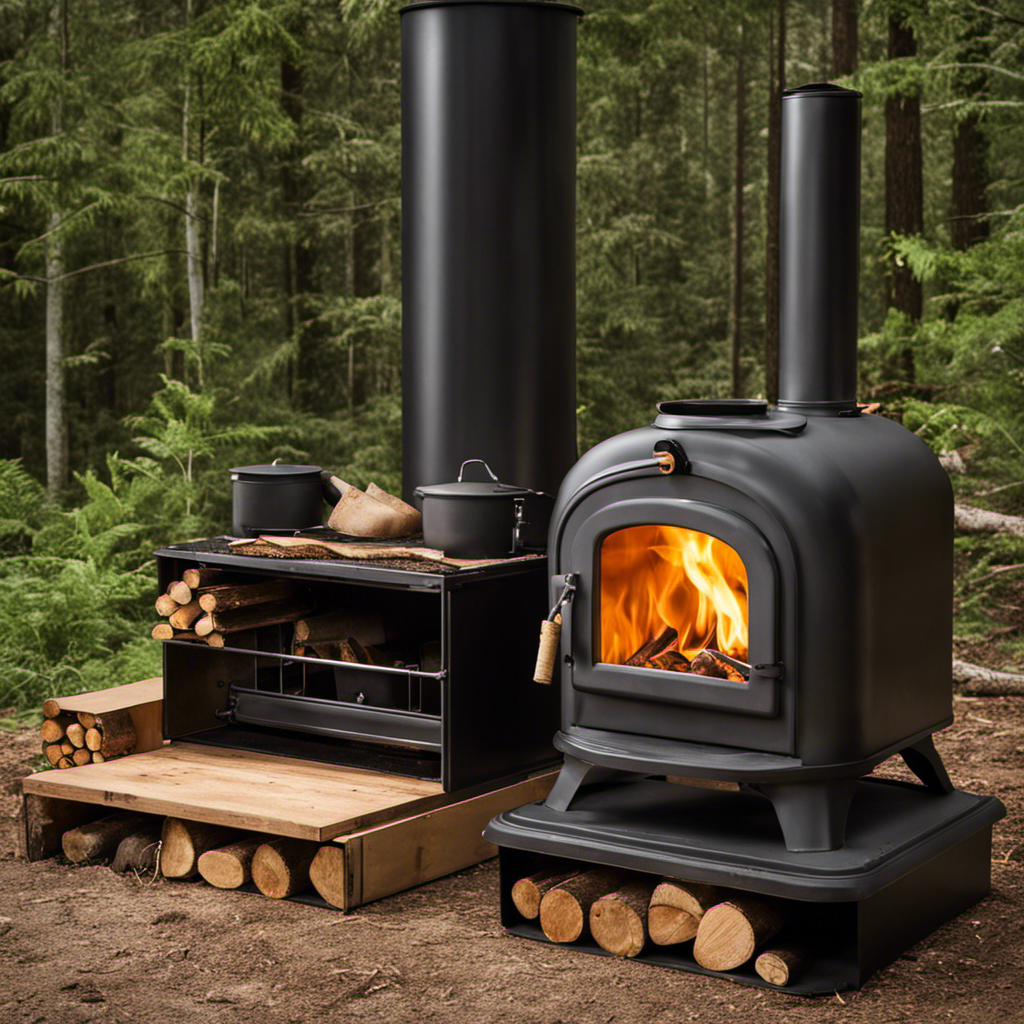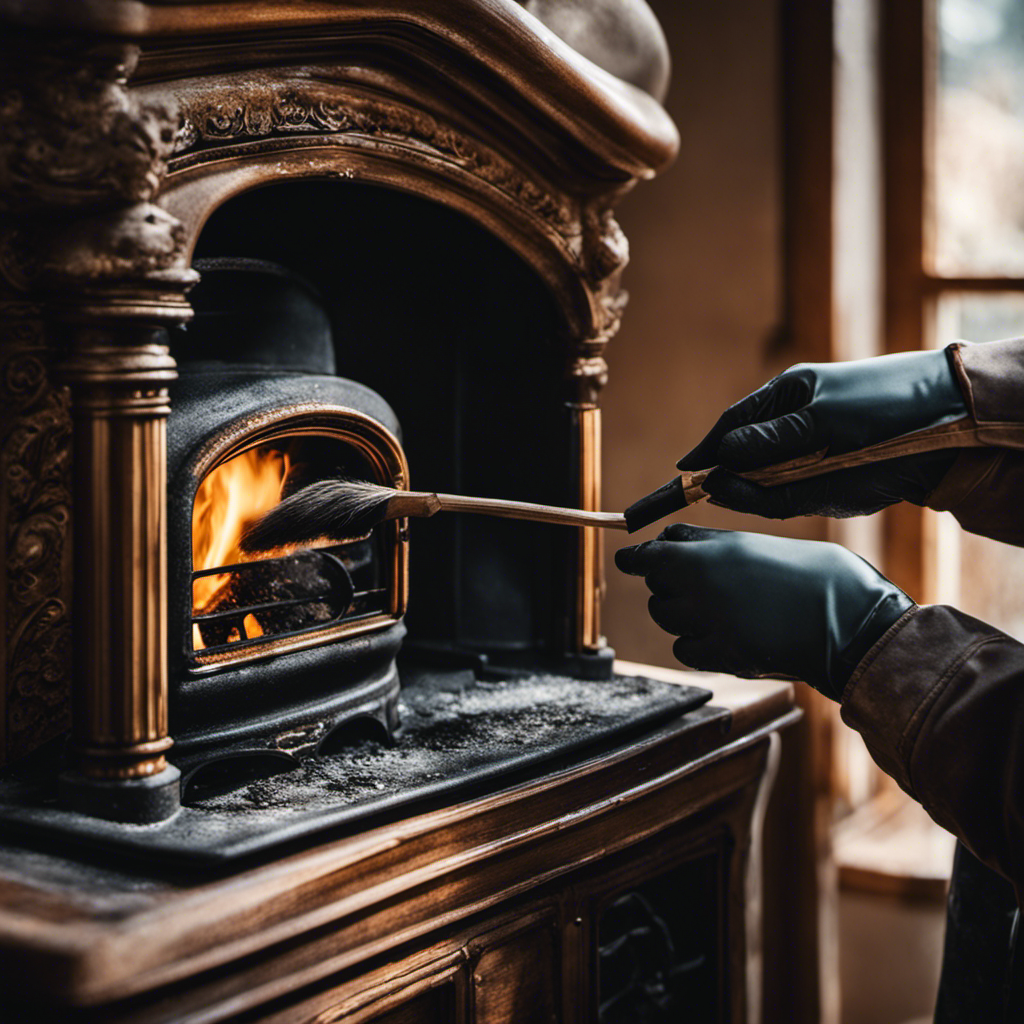Snuggled near the crackling sounds of the fire, I am gently prompted by a gentle nudge that the cold grip of winter has indeed arrived. The graceful spirals of smoke rising from my wood stove’s chimney narrate a story – one that pays tribute to a well-loved and often used fireplace.
But beneath the beauty lies the potential for danger. So, how do we know when it’s time to clean our wood stove chimney?
Let me guide you through the signs, the smells, and the secrets that will keep your home warm and safe.
Key Takeaways
- Excessive smoke and odor, as well as irritation to eyes and lungs, are signs that your wood stove chimney needs cleaning.
- Reduced airflow and draft issues, such as lingering smoke and checking for obstructions, indicate the need for chimney cleaning.
- Creosote buildup in the chimney reduces efficiency and increases the risk of chimney fire, emphasizing the importance of regular maintenance.
- Soot or debris falling into the fireplace and the presence of animals or nesting materials in the chimney are clear indications that cleaning is necessary.
Excessive Smoke or Odor
I can’t stand the excessive smoke and odor coming from my wood stove. It’s becoming a nuisance and affecting the air quality in my home. Not only is the smoke irritating to my eyes and lungs, but the strong odor lingers for hours, making it difficult to enjoy the comfort of my own space.
This issue has prompted me to take action and ensure the safety of my household. First, I installed smoke detectors in strategic locations to alert me in case of any potential fire hazards. Additionally, I invested in a carbon monoxide detector to monitor the levels of this silent and deadly gas.
These precautions give me peace of mind and allow me to enjoy the warmth of my wood stove without the worry of excessive smoke or the risk of carbon monoxide poisoning.
Reduced Airflow or Poor Draft
The wood stove’s reduced airflow is causing the smoke to linger in the room. This can be a sign of a blocked chimney or backdraft issues. Here are three things to consider when dealing with reduced airflow:
-
Check for obstructions: Inspect your chimney to see if there are any blockages, such as bird nests or debris. These can prevent proper airflow and cause smoke to back up into your home.
-
Assess the damper: Make sure the damper is fully open when using the wood stove. A partially closed damper can restrict airflow and lead to smoke accumulation.
-
Clean the flue: Over time, creosote can accumulate in the flue, reducing the diameter and impeding airflow. Regular chimney cleaning can help prevent this buildup and ensure proper ventilation.
When reduced airflow isn’t addressed, it can contribute to the build-up of creosote, a highly flammable substance.
Build-up of Creosote
If left unaddressed, the build-up of creosote can pose a serious fire hazard in your wood stove chimney. Creosote is a highly flammable substance that forms when wood is burned incompletely. Over time, this sticky, tar-like substance accumulates on the inner walls of the chimney.
Not only does creosote reduce the efficiency of your wood stove, but it also increases the risk of a chimney fire. Regular chimney maintenance is crucial to prevent the build-up of creosote.
To remove creosote from your chimney, it’s recommended to hire a professional chimney sweep who has the expertise and proper tools for the job. They’ll thoroughly clean the chimney, ensuring that all creosote deposits are removed.
Soot or Debris Falling Into the Fireplace
There were several times when debris fell into the fireplace, but I quickly cleaned it out to prevent any potential fire hazards. Fireplace maintenance is crucial to ensure the safety and efficiency of your fireplace. Regular chimney inspection is an essential part of this maintenance routine.
Here are three signs that indicate your wood stove chimney may need cleaning:
-
Soot or debris falling into the fireplace: If you notice any debris or soot falling into the fireplace, it’s a clear indication that your chimney needs cleaning. The build-up of creosote and other substances can cause these particles to fall into the fireplace.
-
Smoky or unpleasant odor: A smoky or unpleasant odor coming from your fireplace is another sign that your chimney may be dirty. The accumulation of creosote can cause an unpleasant smell when the fireplace is in use.
-
Poor chimney draft: If you experience difficulty in getting a good draft or if smoke fills the room when you light a fire, it could be due to a blocked chimney. A thorough chimney inspection will help identify and resolve any blockages.
Regular fireplace maintenance and chimney inspection are essential to keep your fireplace functioning safely and efficiently. Don’t neglect these important tasks to ensure a cozy and worry-free winter season.
Animals or Nesting Materials in the Chimney
I recently discovered a bird’s nest in my chimney, and it was causing a blockage that needed to be removed. Birds often build their nests in chimneys because they provide a safe and sheltered environment. However, these nests can lead to serious problems if left unchecked. Not only can they cause blockages, but they can also pose a fire hazard.
Removing bird nests from chimneys requires caution and the use of proper techniques. One method to remove a bird’s nest is by using a chimney brush or vacuum. This allows you to gently dislodge the nest and remove it from the chimney. It’s important to wear protective gear, such as gloves and goggles, to prevent any potential harm from debris or bird droppings.
Another technique is to use a chimney cap or mesh screen to prevent birds from entering the chimney in the first place. This is a proactive approach that can help minimize the chances of future nest blockages.
Overall, it’s crucial to address bird nests in chimneys promptly to ensure proper ventilation and prevent any potential dangers. By employing the right removal techniques and taking preventative measures, you can maintain a safe and functional chimney.
Frequently Asked Questions
How Frequently Should I Clean My Wood Stove Chimney?
I clean my wood stove chimney at least once a year to ensure it’s free from creosote buildup and potential chimney fires. Regular cleaning is important for the safe and efficient operation of your wood stove.
Can a Dirty Chimney Cause a Fire Hazard?
Yes, a dirty chimney can definitely cause a fire hazard. Regular chimney maintenance is crucial for fire prevention. Cleaning the chimney removes built-up creosote, reducing the risk of chimney fires and ensuring safe operation of your wood stove.
What Are the Signs of a Blocked Chimney?
When it comes to the signs of a blocked chimney, there are a few key things to look out for. Regular chimney cleaning is important to prevent fire hazards and ensure proper ventilation.
Are There Any DIY Methods to Clean a Wood Stove Chimney?
There are some DIY chimney cleaning tips that can help maintain your wood stove chimney. Using specialized cleaning products and tools, such as chimney brushes and rods, can effectively remove creosote buildup and ensure proper ventilation.
What Are the Potential Health Risks Associated With a Dirty Wood Stove Chimney?
Potential respiratory problems and a negative impact on indoor air quality can arise from a dirty wood stove chimney. Breathing in the pollutants and toxins released can lead to health issues. Regular cleaning is essential for maintaining a safe and healthy environment.
Conclusion
In conclusion, keeping a close eye on the signs of a dirty wood stove chimney is crucial for ensuring the safety and efficiency of your home heating system.
Much like a river that becomes clogged with debris, a neglected chimney can obstruct the flow of air and lead to a buildup of dangerous creosote.
By regularly inspecting for excessive smoke, reduced airflow, and the presence of soot or debris, you can address any cleaning needs promptly and enjoy a warm and cozy home all winter long.
Logan’s affair with adventure began in childhood. He hailed from a small town where vast forests bordered one side and endless shores stretched on the other. His days were spent exploring uncharted woods, climbing tall trees, or listening to the tales of old sailors. This early immersion in a world brimming with stories and mysteries became the foundation of his passion for writing.











